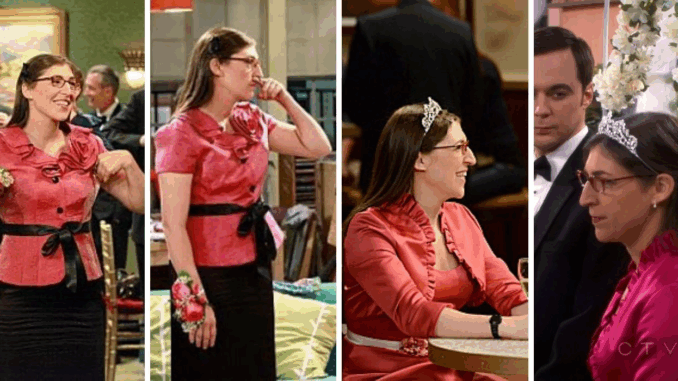
Redefining the Female Nerd on Television
When Amy Farrah Fowler first appeared on The Big Bang Theory, she seemed like a mere female counterpart to Sheldon—a socially awkward, robotic scientist introduced via online matchmaking. But over time, Amy transformed into one of the show’s richest, most compelling characters. Her journey from a stereotypical “female Sheldon” to an emotionally layered woman, a devoted friend, and a Nobel Prize-winning scientist is one of the series’ most triumphant evolutions.
Amy not only redefined her own arc—she helped redefine the portrayal of women in science and comedy.
The Early Amy: A Puzzle with a Shell
Amy’s earliest appearances were deliberately stiff. She matched Sheldon in awkward speech, disinterest in social norms, and obsessive dedication to her work in neurobiology. To many, she felt like a plot device—a mirror to Sheldon, created more for comic effect than emotional resonance.
But the writers and actress Mayim Bialik, herself a neuroscientist, began peeling back Amy’s layers. Beneath her deadpan delivery was someone who deeply longed for connection—someone who had spent much of her life isolated, rejected, or ignored. That emotional honesty set the stage for one of the most satisfying character arcs on the show.
The Power of Female Friendship: Amy, Penny, and Bernadette
One of the most transformative relationships in Amy’s life wasn’t romantic—it was her unexpected friendship with Penny and later Bernadette. Amy’s idolization of Penny at first was exaggerated to comedic extremes, but beneath the jokes was something raw: a woman finally experiencing sisterhood and friendship.
Through sleepovers, wine nights, and shared secrets, Amy grew into her own identity. She gained confidence not by changing who she was but by expanding what she thought was possible. Penny’s outgoing, emotionally expressive style and Bernadette’s assertiveness provided Amy with role models—and, eventually, equals.
Together, they formed a trio that balanced science, sass, and sincerity in a way rarely seen on sitcoms.
Love, Consent, and Growth with Sheldon Cooper

Amy’s relationship with Sheldon was anything but conventional—and that’s what made it revolutionary. It wasn’t about quick chemistry or physical passion. It was about learning how to communicate, to compromise, to grow.
Amy was patient but firm. She didn’t settle for scraps of affection. She challenged Sheldon to evolve, but never tried to “fix” him. When she asked for space after he took her for granted, it was a moment of quiet power. And when they finally consummated their relationship, it was treated with rare dignity for a sitcom—funny, yes, but also deeply human.
Their eventual marriage wasn’t a fairy tale—it was the result of years of shared effort, vulnerability, and emotional labor. Amy didn’t tame Sheldon; she met him where he was and helped him grow.
Championing Women in STEM Through Humor and Heart
Amy’s career in neuroscience was never sidelined. In fact, it was celebrated. She had her own scientific wins, independent of Sheldon or the boys. Her intellectual passions—from brain scans to monkey studies—were part of who she was.
And in the final season, Amy shared a Nobel Prize in Physics with Sheldon. That victory wasn’t just a plot point—it was a declaration: women in STEM can be complex, funny, feminine, awkward, brilliant, and celebrated all at once.
Mayim Bialik’s real-life advocacy for women in science made Amy’s accomplishments feel all the more authentic. Amy became a role model for young viewers—not because she was flawless, but because she was real.
Fashion, Femininity, and Self-Discovery
Another subtle yet significant part of Amy’s growth was her relationship with femininity. In early seasons, Amy dressed plainly, almost as a barrier against the world. But as her confidence grew, so did her wardrobe—more colors, softer fabrics, better fits.
Her glow-up was never about appeasing men; it was about expressing comfort and joy in her own skin. It mirrored the way many women—especially those in male-dominated fields—slowly reclaim space for themselves without compromising their integrity.
The Finale: A Victory Earned, Not Given
Amy’s speech at the Nobel ceremony was brief but powerful. She thanked the women who came before her and encouraged young girls to pursue science. It was a mic-drop moment—one of the few times in network television where a woman scientist wasn’t a joke or sidekick but the centerpiece of success.
Amy didn’t just end up with a ring—she ended up with a legacy.
Conclusion: From Side Character to Symbol of Strength
Amy Farrah Fowler began as a stereotype and ended as a star. Her transformation was a testament to what happens when writers invest in character depth and emotional authenticity. She made us laugh, yes—but she also made us feel.
Through Amy, The Big Bang Theory told a story about intellect, friendship, feminism, love, and resilience. And in doing so, it gave audiences one of the most relatable, empowering portrayals of a woman in television history.
Amy’s story wasn’t just about finding love—it was about finding herself. And in that journey, millions of viewers found a piece of themselves, too.
